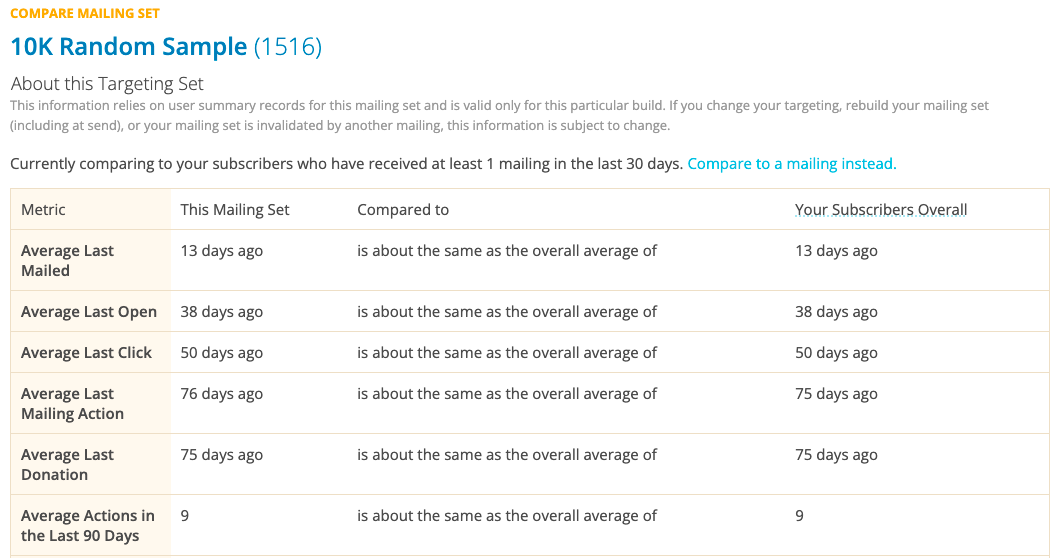Compare Mailing Sets¶
Overview¶
Once you’ve built your mailing set, we’ll calculate statistics about those recipients so you can see how they compare to subscribed users on your list who have received mailings recently. We’ll show a brief summary of this information on the Proof and Send screen, and more detailed information on the Compare Mailing Set screen.

A brief summary appears on the Proof and Send screen once your mailing targeting has built and we’ve analyzed your mailing set.¶
The mailing in this example screenshot is targeted to a random sample of users on the mailing list, so it’s expected that these users have about average opens.

More detailed information available on the Compare Mailing Set screen.¶
This table shows more detailed information about the mailing targeting set. Since this example mailing is targeted to a random sample of users on the mailing list, it’s expected that the values for this mailing set are about average.
By default, your mailings are compared against a daily snapshot of the summary_user table for subscribed users who have received at least 1 mailing in the last 30 days to determine these averages. If your mailing targeting patterns differ from these expectations, you might get more meaningful results by comparing to other mailings instead.
Note
These calculations happen separately from the build process, so they’ll never slow down your mailing counts.
Interpreting the data¶
Many of the stats in the tables reference a certain number of “days ago”, for example: the Average Last Mailed for your mailing was 13 days ago. This means that on average, users in this mailing set have been mailed about 13 days ago, relative to when this mailing was built.
But if a large portion of users in your mailing set aren’t contributing data (see the Limitations of this data chart, if shown), then those averages may be less useful. In the above screenshot, 0.6% of users have no recent activity at all – no opens, clicks, actions, donations, or mailings sent – but that’s probably not enough to skew the data. However, if 60% of the users in this mailing set had no activity, that would make the averages much less meaningful.
Each category of activity also has its own breakdown. Most commonly you’ll see the “Without recent donations” qualifier, because it’s unlikely that every subscribed user on your list is a donor.
Can’t always be above average¶
Keep in mind that these stats are offered as general guidelines to help you better understand your mailing targeting sets, but there’s no one-size-fits-all approach. For example, if you’re sending a re-engagement mailing, it’s expected that the targeting set for that mailing is going to be less active than average. On the other hand, targeting to an active segment should be more active than average.
In other words, whether your mailing set’s stats are above, below, or about average depends largely on your targeting criteria, mailing calendar, and several other factors.
General Guidelines¶
The Compare Mailing Set tool is designed to help you better understand your mailing sets and avoid targeting mistakes. If you’re targeting a random sample of your list, you’re likely to get average results. If you’re targeting actives, your mailing set is likely to be better than average on most stats including opens, clicks, and actions. If you’re targeting prior donors, your mailing set is likely to have a more recent average last donation.
On the other hand, if you have a mailing that’s excluding a mailing that’s targeting to actives (whether you’re excluding that mailing manually or using the auto-excludes feature), that mailing will probably have less recent opens, clicks, and actions because you’re excluding some portion of your active audience already. That’s not necessarily a bad thing, but it can help explain why some mailing sets have very different results.
Rebuilding your targeting set¶
These metrics are only valid for a mailing’s current targeting set. ANY change to your mailing’s targeting will invalidate these results, as will rebuilding your mailing (even at send), or having your mailing targeting set invalidated by another mailing.
Unless there was a change to your mailing’s targeting, the results will probably be about the same as they were for the previous build. Previous versions are not saved for comparison – when your mailing targeting builds it will overwrite the previous stats.
Mailings that are rebuilt at send will get a new mailing targeting summary saved for your future reporting needs.
Comparing to Other Mailings¶
You can compare one mailing set to another, but only for mailings that have a mailing targeting set summary. (In other words, mailings whose targeting was built before this feature was added aren’t available for comparison.)
If you want to compare more than two mailing targeting sets, use the Query Builder for Mailings queries. All of the stats, including the daily snapshots of the summary_user table, are available under Mailing Targeting Set Summary options.